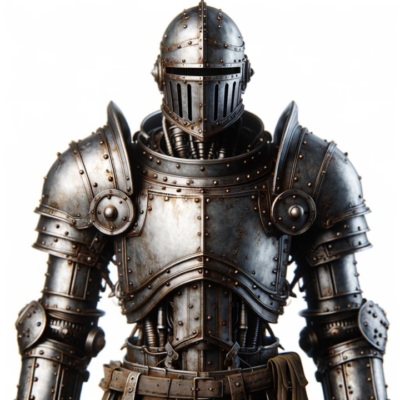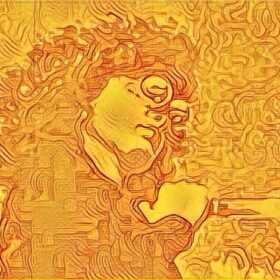Swords of the Serpentine
Playtesting: Constructs (Non-Human Heroes) in Swords of the Serpentine
 By Kevin Kulp
By Kevin Kulp
Our series on non-human heroes has so far covered Intelligent Animals, Unsleeping Advisors (secret undead), and the Considerata (humans whose souls are contractually linked to gods). This month’s Ancestry is inspired by gargoyles, golems, warforged, and clockwork creations. Be sure to read the previously published rules on Non-Human Heroes if you haven’t already.
Construct
Ancestry abilities: Ancestry (Construct), City’s Secrets, Felonious Intent, Spot Frailty
- Ancestry (Construct) reflects your self-aware knowledge of being a construct, as well as your cultural and societal links to other constructs
- City Secrets represents your intuitive understanding of cities, architecture, and non-living wood and stone construction
- Felonious Intent represents your ability to notice stress and nervousness in others, a talent gained by sitting motionless and unnoticed for endless hours as humans walked past you
- Spot Frailty reflects your ability to see flaws and stress cracks in personalities and constructed items around you, along with an innate sense of how best to exploit those weaknesses
You are an intelligent and self-aware construct, a living automaton whose body is made from wood, stone, metal, wax, or even stained glass. You might be a magically animated statue, a clockwork construction, a suit of haunted plate armor, a carved gargoyle, a living candle-man whose flame burns away your soul, or something similar. Your size is whatever you choose between a toddler and a hulking man, but you’re denser and heavier than a comparably sized human. You move at normal human speed.
The material you’re constructed from gives you the equivalent of Armor that cannot be removed while you live; choose between Armor 1, Armor 2 (the Difficulty on any Athletics test to swim rises by +4), and Armor 3 (the Difficulty on any Athletics test to swim rises by +6). You do not need to breathe, eat, or drink, but sinking underwater can still inconvenience you. You are unaffected by poisons and diseases that don’t have sorcery or curses woven into them.
You have efficient magical or mechanical internal repair mechanisms, and for you Bind Wounds’ functioning is reversed. Every point you spend from your Bind Wounds pool restores 2 Health points to yourself or 1 Health point to someone else who is injured. If your Bind Wounds rating is 8 or more, you can heal others as efficiently as you can heal yourself. If others heal you with their points of Bind Wounds, they will only restore 1 Health point to you per Bind Wounds point they spend.
Most constructs are constructed to serve as guards or soldiers. Ancestry abilities encourage you to have a mystical connection to your current city, the ability to notice ne’er-do-wells, and the strength and precision to smash anything in your way.
Play a construct if you want to feel tied to the city, if you like the idea of being a guard or protector, and if you want to explore what it means to be crafted instead of born.
Designer Notes: Constructs
Cinematic, literary, and gaming-based inspirations such as 1981’s Clash of the Titans, Sir Terry Pratchett’s Discworld, and D&D’s Eberron all feature heroes and characters who are constructed instead of born. Not having flesh confers both advantages and disadvantages; we chose self-reliant healing, no need to eat or breathe, and an unfortunate tendency to sink due to armor. Any other unusual advantages of being a construct are handled through Ancestry (Construct) spends.
Investigative ability: Ancestry (Construct)
You are a constructed creature. You have knowledge of who built you and why (unless you wish to find out this information during play), and you’re familiar with the culture, behavior, history, superstitions, art, tactics, and territory of other constructs.
This Investigative ability points you towards leads and clues that are linked to constructs or the people who create them. You will need to rely on other Investigative abilities to gain leads from specific constructs or their creators.
Sample spend: Make a construct supporting character particularly like and trust you, or at least not attack you until discussion is concluded. Blend into the background while appearing as a non-living, unanimated statue or item. Temporarily reshape your body into a more convenient form. Do an extra die of damage on a Warfare attack due to your great natural strength. Shut yourself down for a long period of time, remaining barely aware of your surroundings and awakening when needed. If you are a construct with wings (like a gargoyle), fly slowly and clumsily for the scene.
Character Creation Advice
- There are many types of constructs, from ancient automaton soldiers to sentient stone gargoyles. They all have the same Ancestry, so pick one that will be most interesting for you to play and build story around.
- You get to decide how naturally armored you are. This makes constructs a good choice for frontline Heroes; add a shield, and perhaps some ranks in Taunt to attract your enemy’s attacks, and you’re going to be hard for your many enemies to hit and hurt!
- You can decide how old you are. You could be an ancient golem constructed by the Serpentine a millennium before Eversink rose from the swamp, or you could be a ghost-possessed statue who first achieved mobility and sentience last month. If you’re ancient and have a good memory, consider investing in ranks of Forgotten Lore.
- If you want to play a construct that can literally rip apart stone or punch through armor, invest ranks in the ability Spot Frailty and spend those points liberally.
- Constructs make great members of the City Watch, assuming the Watch is smart enough to hire them. Most can blend into the background, remain motionless for long periods, and spot signs of human stress.
- What you look like is only limited by your imagination and the tone of the game. Feel free to propose an appearance and background you find particularly fun (clockwork assassin! Magically-hardened stained glass with the appearance of a famous saint!) to the GM, but don’t be surprised if she asks you to consider alternatives that more closely fit the game’s tone.

Sample Hero – Construct
Cathedral, Construct gargoyle
Patient, observant, stone-faced, protective, apparently humorless
Drives (what is best in life?): Rainwater sluicing through your mouth; stone crushing flesh; understanding a joke
Defenses – Health: Health Threshold 4, Armor 3 (carved stone), Health 10
Defenses – Morale: Morale Threshold 3, Grit 1 (thoughtful), Morale 8
Offense – Sway: Sway 2: Damage Modifier +1 (fear)
Offense – Warfare: Warfare 10: Damage Modifier +1 (claws) or +2 (crushing weight)
Investigative abilities: Intimidation 1, Servility 1; Ancestry (Construct) 4, City Secrets 1, Felonious Intent 1, Spot Frailty 3
Allegiances: Ally: Church of Denari 2; Enemy: Architects and Canal-Watchers 1
General abilities: Athletics 7, Preparedness 3, Stealth 8 (Where’d She Go?), Sway 2, Warfare 10 (Cleave)
Gear: The ability to be motionless or to move in stop-motion; eight centuries of carefully-tended moss growing on your back; an undying hatred of birds; surprisingly-sharp claws; a friendship with stone, although you’re currently having a disagreement.
Sample Adversary – Construct
Assassin Statue
Sly, subtle, precise
Defense — Health: Health Threshold 4, Armor 4 (and see Stony), Health 30
Defense — Morale: Morale Threshold nil, Morale nil
Offense — Warfare: +1; Damage Modifier +3 (stone fist or sword)
Abilities: Malus 12
Special Abilities: Defense Boost (cost 6), Disguise (cost varies – 1 or 3), Monstrous Ability (cost 3), Regenerate (cost 0 – regenerates at end of scene), Stony, Strength
Refresh Tokens: 5
Description: An assassin statue is an animated statue designed to blend into the background and cunningly kill anyone it is unleashed on, usually through a specific attunement method. It has no Morale and cannot be injured by attacks against Morale.
Assassin statues have an innate knowledge of Eversink. If they need to reach their target they can smash through walls with their Monstrous Ability spend (duplicating a Spot Frailty spend), and can disguise themselves as another statue.
Sample Allegiances
Establishing constructs as a unique faction indicates they are connected, organized, and wielding political pressure. This may occur surreptitiously, such as a city’s clockwork laborers gradually waking up to secret sentience and realizing their true power to keep the city running smoothly, or obviously, as a city’s ancient golem army rebelling and demanding their own rights at swordpoint.
Having constructs as Allies means that they consider you steady, stable and friendly to their cause. They’ll help you in your time of need and expect you to reciprocate. Use your relationship to learn about the areas where constructs labor or dwell, the artisans who created them, and the labor to which they have traditionally been put.
Constructs tend to be more direct than wily. Having constructs as Enemies means that they consider you a betrayer or a traitor, and you may want to expect falling paving stones while walking near gargoyle-covered buildings. Seemingly implacable guard-golems have been reported attacking their enemies to the exclusion of any humans nearby.
Kevin Kulp (@kevinkulp) and Emily Dresner (@multiplexer) are the co-authors of Swords of the Serpentine, out now in hardback and PDF. Kevin previously helped create TimeWatch and Owl Hoot Trail for Pelgrane Press. When he’s not writing games he’s either smoking BBQ or helping 24-hour companies with shiftwork, sleep, and alertness.


